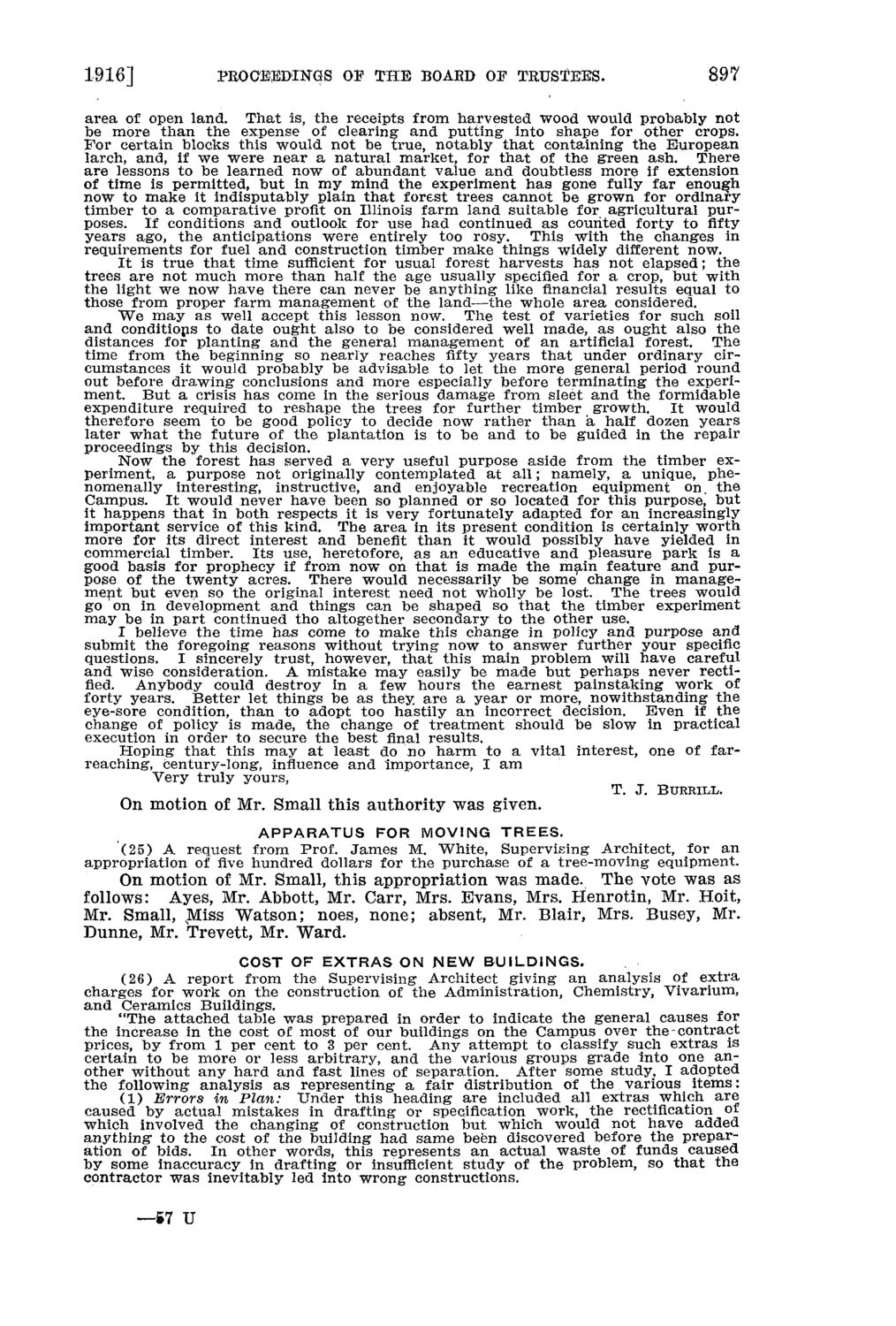| |
| |
Caption: Board of Trustees Minutes - 1916
This is a reduced-resolution page image for fast online browsing.

EXTRACTED TEXT FROM PAGE:
1916] PROCEEDINGS OP THE BOARD OF TRUSTEES. 897 area of open land. That is, the receipts from harvested wood would probably not be more than the expense of clearing and putting into shape for other crops. For certain blocks this would not be true, notably that containing the European larch, and, if we were near a natural market, for that of the green ash. There are lessons to be learned now of abundant value and doubtless more if extension of time is permitted, but in my mind the experiment has gone fully far enough now to make it indisputably plain that forest trees cannot be grown for ordinary timber to a comparative profit on Illinois farm land suitable for agricultural purposes. If conditions and outlook for use had continued as counted forty to fifty years ago, the anticipations were entirely too rosy. This with the changes in requirements for fuel and construction timber make things widely different now. It is true that time sufficient for usual forest harvests has not elapsed; the trees are not much more than half the age usually specified for a crop, but with the light we now have there can never be anything like financial results equal to those from proper farm management of the land-—the whole area considered. We may as well accept this lesson now. The test of varieties for such soil and conditions to date ought also to be considered well made, as ought also the distances for planting and the general management of an artificial forest. The time from the beginning so nearly reaches fifty years that under ordinary circumstances it would probably be advisable to let the more general period round out before drawing conclusions and more especially before terminating the experiment. But a crisis has come in the serious damage from sleet and the formidable expenditure required to reshape the trees for further timber growth. It would therefore seem to be good policy to decide now rather than a half dozen years later what the future of the plantation is to be and to be guided in the repair proceedings by this decision. Now the forest has served a very useful purpose aside from the timber experiment, a purpose not originally contemplated at all; namely, a unique, phenomenally interesting, instructive, and enjoyable recreation equipment on. the Campus. It would never have been so planned or so located for this purpose, but it happens that in both respects it is very fortunately adapted for an increasingly important service of this kind. The area in its present condition is certainly worth more for its direct interest and benefit than it would possibly have yielded in commercial timber. Its use, heretofore, as an educative and pleasure park is a good basis for prophecy if from now on that is made the main feature and purpose of the twenty acres. There would necessarily be some change in management but even so the original interest need not wholly be lost. The trees would go on in development and things can be shaped so that the timber experiment may be in part continued tho altogether secondary to the other use. I believe the time has come to make this change in policy and purpose and submit the foregoing reasons without trying now to answer further your specific questions. I sincerely trust, however, that this main problem will have careful and wise consideration. A mistake may easily be made but perhaps never rectified. Anybody could destroy in a few hours the earnest painstaking work of forty years. Better let things be as they are a year or more, nowithstanding the eye-sore condition, than to adopt too hastily an incorrect decision. Even if the change of policy is made, the change of treatment should be slow in practical execution in order to secure the best final results. Hoping that this may at least do no harm to a vital interest, one of farreaching, century-long, influence and importance, I am Very truly yours, T. J. BURRILL. On motion of Mr. Small this authority was given. A P P A R A T U S FOR MOVING TREES. (25) A request from Prof. James M. White, Supervising Architect, for an appropriation of five hundred dollars for the purchase of a tree-moving equipment. On motion of Mr. Small, this appropriation was made. The vote was as follows: Ayes, Mr. Abbott, Mr. Carr, Mrs. Evans, Mrs. Henrotin, Mr. Hoit, Mr. Small, .Miss Watson; noes, none; absent, Mr. Blair, Mrs. Busey, Mr. Dunne, Mr. Trevett, Mr. Ward. COST OF E X T R A S ON N E W BUILDINGS. (26) A report from the Supervising Architect giving an analysis of extra charges for work on the construction of the Administration, Chemistry, Vivarium, and Ceramics Buildings. "The attached table was prepared in order to indicate the general causes for the increase in the cost of most of our buildings on the Campus over the-contract prices, by from 1 per cent to 3 per cent. Any attempt to classify such extras is certain to be more or less arbitrary, and the various groups grade into one another without any hard and fast lines of separation. After some study, I adopted the following analysis as representing a fair distribution of the various items: (1) Errors in Plan: Under this heading are included all extras which are caused by actual mistakes in drafting or specification work, the rectification of which involved the changing of construction but which would not have added anything to the cost of the building had same been discovered before the preparation of bids. In other words, this represents an actual waste of funds caused by some inaccuracy in drafting or insufficient study of the problem, so that the contractor was inevitably led into wrong constructions. —57 U
| |